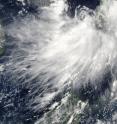NASA's Aqua Satellite sees Tropical Storm Conson now in South China Sea
NASA satellite imagery confirmed that Tropical Storm Conson is departing the Philippines and is almost entirely in the South China Sea. At 1500 UTC (10 a.m. EDT/10 p.m. local Asia/Manila time) on July 14, Tropical Storm Conson was located about 225 nautical miles west-northwest of Manila, the Philippines. That places Conson's center near 16.3 North and 116.9 East. Conson had maximum sustained winds near 50 knots (57 mph) and was moving west-northwest near 12 knots (14 mph). Conson is generating maximum wave heights of 15 feet in the South China Sea.
The Moderate Resolution Imaging Spectroradiometer (MODIS) instrument that flies aboard NASA's Aqua satellite captured a visible image of Tropical Storm Conson in the South China Sea on July 13 at 540 UTC (1:40 a.m. EDT/1:40 p.m. local Asia/Manila time). Conson is being battered by strong vertical wind shear at about 30 knots (34 mph) and the visible imagery shows that Conson no longer has the tropical cyclone signature rounded shape. For a time, Conson's center was fully exposed to winds but it has re-developed. Most of the strongest convection (rapidly rising air that forms thunderstorms) remained south of the partially exposed low-level center.
The Joint Typhoon Warning Center forecasts that Conson "should make landfall near Zhanjiang, China near 16/18z (July 16 at 1800 Zulu Time, or 2 p.m. EDT). Conson is expected to maintain intensity over the next day and then begin weakening before it makes landfall.
Source: NASA/Goddard Space Flight Center
Articles on the same topic
- High pressure forcing Tropical Storm Conson farther south to Hainan IslandThu, 15 Jul 2010, 16:49:55 UTC
- NASA's 3-D animation of Typhoon Conson's heavy rainfall and strong thunderstormsTue, 13 Jul 2010, 20:30:15 UTC
- Tropical Storm Conson sweeping through the Northern PhilippinesTue, 13 Jul 2010, 19:42:31 UTC
- Tropical Storm Conson forms in northwestern PacificMon, 12 Jul 2010, 21:36:08 UTC
Other sources
- High pressure forcing Tropical Storm Conson farther south to Hainan Islandfrom PhysorgThu, 15 Jul 2010, 20:21:50 UTC
- High pressure forcing Tropical Storm Conson farther south to Hainan Islandfrom Science BlogThu, 15 Jul 2010, 18:21:10 UTC
- NASA's Aqua Satellite sees Tropical Storm Conson now in South China Seafrom PhysorgWed, 14 Jul 2010, 21:21:25 UTC
- NASA’s Aqua Satellite sees Tropical Storm Conson now in South China Seafrom Science BlogWed, 14 Jul 2010, 20:28:12 UTC
- NASA's 3-D animation of Typhoon Conson's heavy rainfall and strong thunderstormsfrom Science DailyWed, 14 Jul 2010, 1:28:15 UTC
- Tropical Storm Conson sweeping through the Northern Philippinesfrom PhysorgTue, 13 Jul 2010, 21:21:28 UTC
- NASA’s 3-D animation of Typhoon Conson’s heavy rainfall and strong thunderstormsfrom Science BlogTue, 13 Jul 2010, 21:14:11 UTC
- NASA's 3-D animation of Typhoon Conson's heavy rainfall and strong thunderstorms (w/ Video)from PhysorgTue, 13 Jul 2010, 20:56:24 UTC
- Tropical Storm Conson sweeping through the Northern Philippinesfrom Science BlogTue, 13 Jul 2010, 20:07:14 UTC
- Tropical Storm Conson forms in northwestern Pacificfrom Science BlogMon, 12 Jul 2010, 22:21:08 UTC
- Tropical Storm Conson forms in northwestern Pacificfrom PhysorgMon, 12 Jul 2010, 21:35:14 UTC
